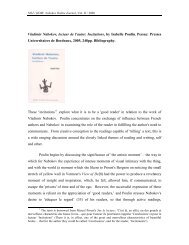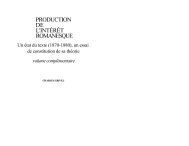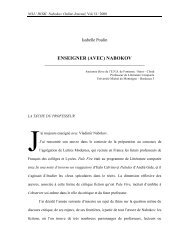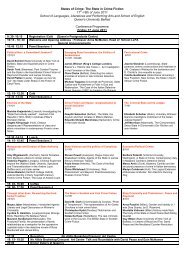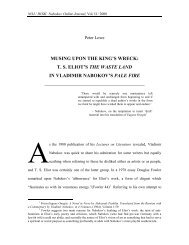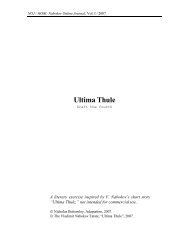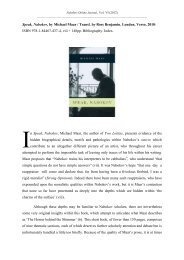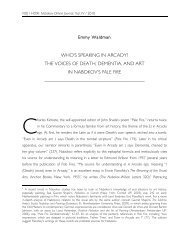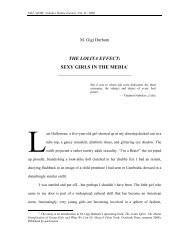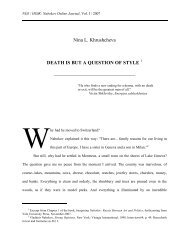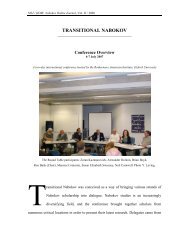domesticated translation: the case of nabokov's translation of alice's
domesticated translation: the case of nabokov's translation of alice's
domesticated translation: the case of nabokov's translation of alice's
Create successful ePaper yourself
Turn your PDF publications into a flip-book with our unique Google optimized e-Paper software.
N. Vid. “Domesticated Translation”<br />
least not as <strong>the</strong> children’s folk verse “Chizhyk-Pyzhik, gde ty byl,” used to translate a<br />
parody <strong>of</strong> <strong>the</strong> famous nursery rhyme “Twinkle Twinkle, Little Star.”<br />
By choosing <strong>the</strong> strategy <strong>of</strong> substitution, Nabokov manipulated famous verses <strong>of</strong><br />
<strong>the</strong> target culture in order to ensure that <strong>the</strong> text is as meaningful and as accessible to <strong>the</strong><br />
target text reader as it was to <strong>the</strong> source text reader.<br />
CULTURAL ADAPTATIONS<br />
“Since successful <strong>translation</strong> depends on a double awareness <strong>of</strong> <strong>the</strong> cultural<br />
context in which <strong>the</strong> original was produced and <strong>of</strong> <strong>the</strong> context into which it is to be<br />
projected,” says Brower in his Introduction to <strong>the</strong> collection <strong>of</strong> essays on <strong>translation</strong>, “it<br />
will <strong>of</strong>ten reveal strikingly <strong>the</strong> likeness and differences between two civilizations”<br />
(Brower 1966: 5). Carroll’s novel reflects <strong>the</strong> time in which it was written. According to<br />
Hagfors, <strong>the</strong> use <strong>of</strong> culture-bound elements, such as proper names, food items, measures<br />
<strong>of</strong> length and currency, histocial figures, etc., is “one way <strong>of</strong> demonstrating not only into<br />
which culture <strong>the</strong> story is set but also <strong>of</strong> creating an atmosphere that reflects <strong>the</strong> values<br />
prevalent in that culture and period <strong>of</strong> time” (2003: 188). She stresses that to translate a<br />
book is a special challenge because <strong>the</strong> translator and <strong>the</strong> publisher have to decide<br />
whe<strong>the</strong>r “<strong>the</strong>y want to imply <strong>the</strong>se same values for <strong>the</strong> target text readers, or whe<strong>the</strong>r <strong>the</strong>y<br />
want to make adaptations to <strong>the</strong> text in order to fit it better into <strong>the</strong> target culture”<br />
because <strong>the</strong>ir decision will define <strong>the</strong> text’s “destiny” in <strong>the</strong> target culture (2003: 118).<br />
There are many British cultural references in Alice that can become problematic<br />
in <strong>translation</strong>. When dealing with cultural elements, Nabokov’s <strong>translation</strong> adopts <strong>the</strong>



